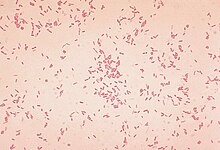| Aeromonas | |
|---|---|

| |
| Aeromonas hydrophila | |
| Scientific classification | |
| Domain: | Bacteria |
| Phylum: | Pseudomonadota |
| Class: | Gammaproteobacteria |
| Order: | Aeromonadales |
| Family: | Aeromonadaceae |
| Genus: | Aeromonas Stanier 1943 |
| Species | |
|
A. aquariorum | |
Aeromonas is a genus of Gram-negative, facultative anaerobic, rod-shaped, bacteria that morphologically resemble members of the family Enterobacteriaceae. Most of the 14 described species have been associated with human diseases. The most important pathogens are A. hydrophila, A. caviae, and A. veronii biovar sobria. The organisms are ubiquitous in fresh and brackish water.[2]
They group with the gamma subclass of the Proteobacteria.[3]
Two major diseases associated with Aeromonas are gastroenteritis and wound infections, with or without bacteremia. Gastroenteritis typically occurs after the ingestion of contaminated water or food, whereas wound infections result from exposure to contaminated water. In its most severe form, Aeromonas spp. can cause necrotizing fasciitis, which is life-threatening, usually requiring treatment with antibiotics and even amputation.[4]
Although some potential virulence factors (e.g. endotoxins, hemolysins, enterotoxins, adherence factors) have been identified, their precise roles are unknown.[5][6]
- ^ a b c d e Parte, A. C. "Aeromonas". LPSN.
- ^ Graf J, ed. (2015). Aeromonas. Caister Academic Press. ISBN 978-1-908230-56-0.
- ^ Martinez-Murcia AJ, Benlloch S, Collins MD (July 1992). "Phylogenetic interrelationships of members of the genera Aeromonas and Plesiomonas as determined by 16S ribosomal DNA sequencing: lack of congruence with results of DNA-DNA hybridizations". International Journal of Systematic and Evolutionary Microbiology. 42 (3): 412–21. doi:10.1099/00207713-42-3-412. PMID 1380289.
- ^ Minnaganti, Venkat R.; Patel, Pankaj J.; Iancu, Dan; Schoch, Paul E.; Cunha, Burke A. (2000). "Necrotizing fasciitis caused by Aeromonas hydrophila". Heart & Lung: The Journal of Acute and Critical Care. 29 (4): 306–308. doi:10.1067/mhl.2000.106723. ISSN 0147-9563. PMID 10900069.
- ^ Ghenghesh, Khalifa Sifaw; Ahmed, Salwa F.; Cappuccinelli, Piero; Klena, John D. (2014-09-09). "Genospecies and virulence factors of Aeromonas species in different sources in a North African country". The Libyan Journal of Medicine. 9 (1): 10.3402/ljm.v9.25497. doi:10.3402/ljm.v9.25497. ISSN 1993-2820. PMC 4161726. PMID 25216211.
- ^ Igbinosa, Isoken H.; Igumbor, Ehimario U.; Aghdasi, Farhad; Tom, Mvuyo; Okoh, Anthony I. (2012-06-04). "Emerging Aeromonas Species Infections and Their Significance in Public Health". The Scientific World Journal. 2012: 625023. doi:10.1100/2012/625023. ISSN 2356-6140. PMC 3373137. PMID 22701365.